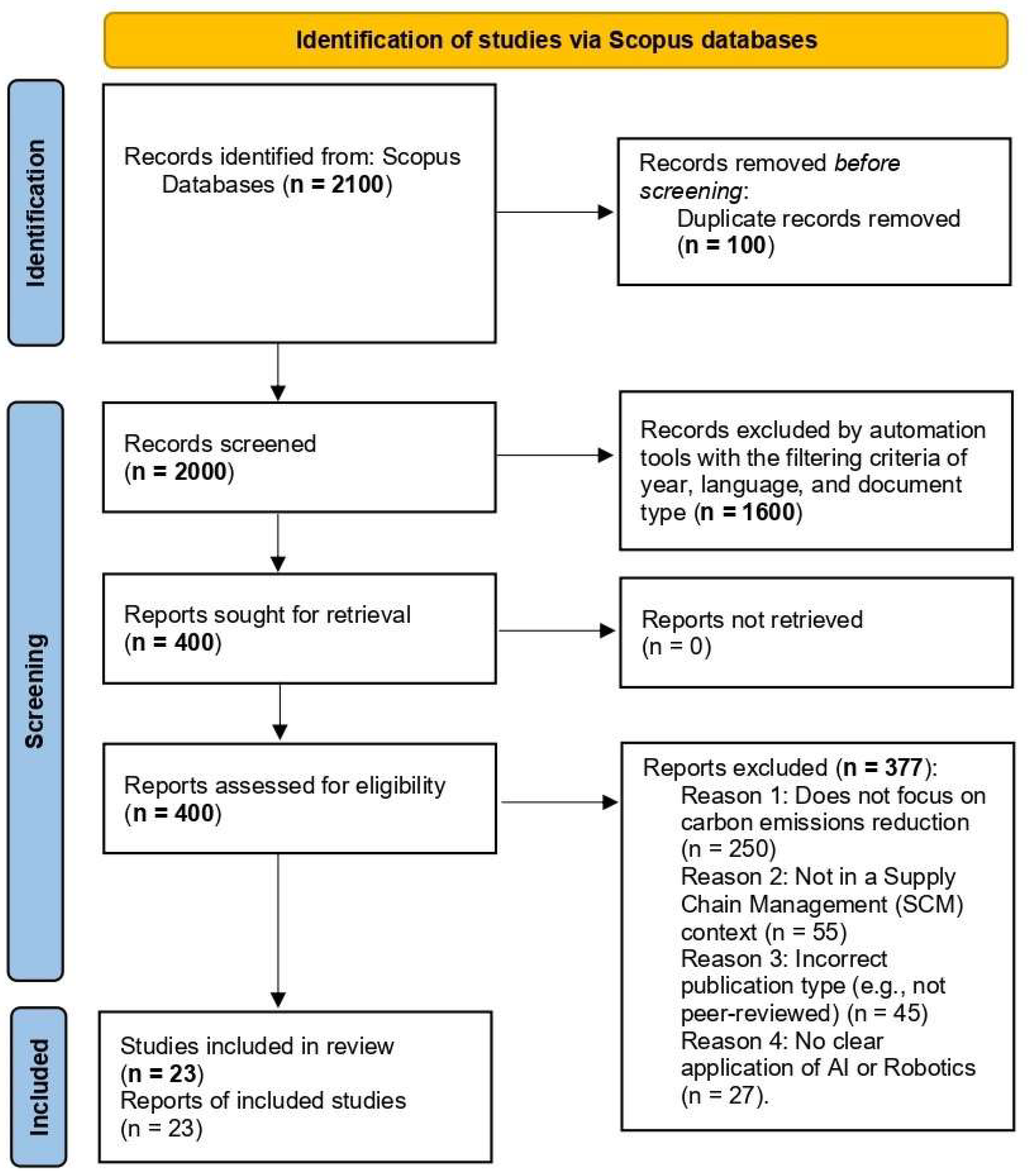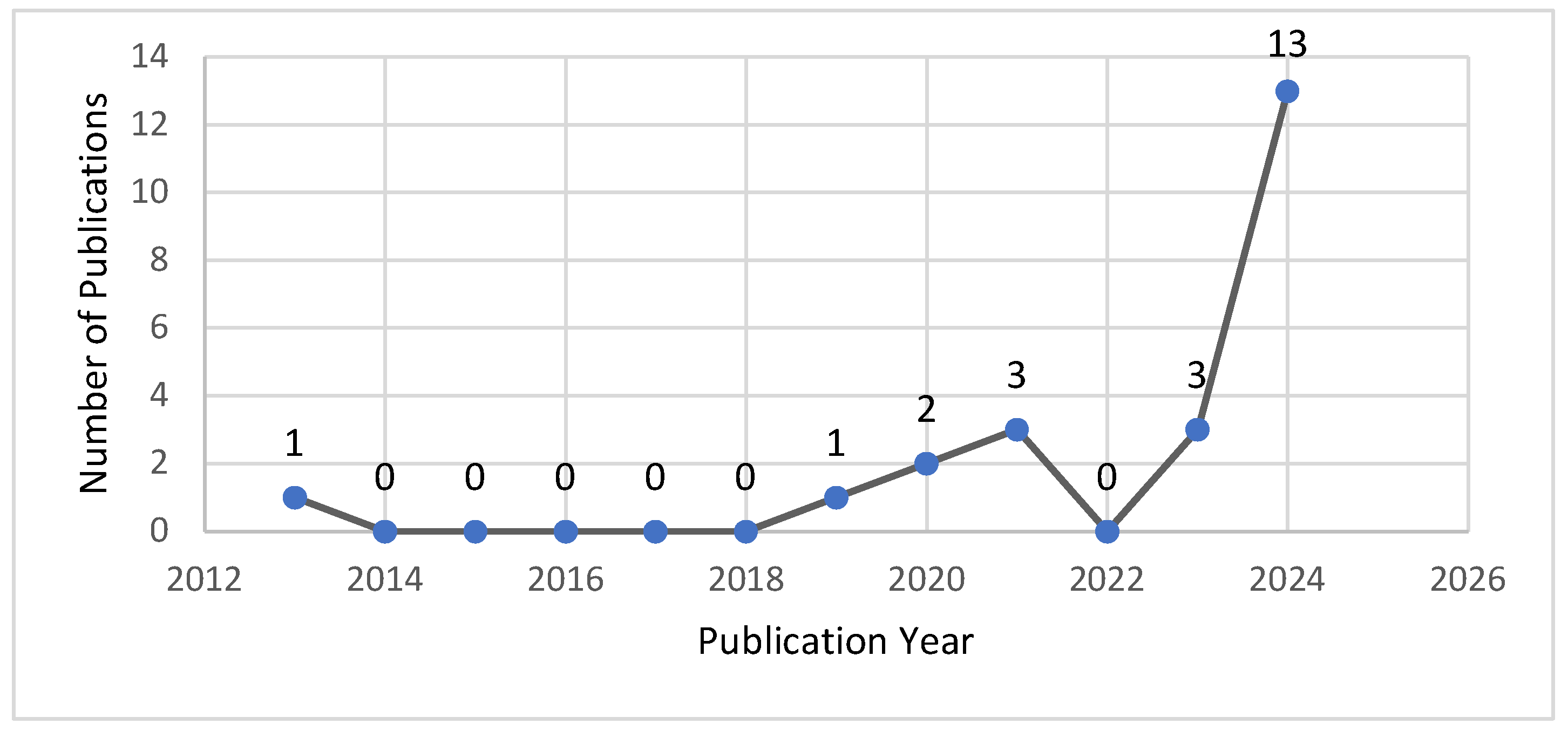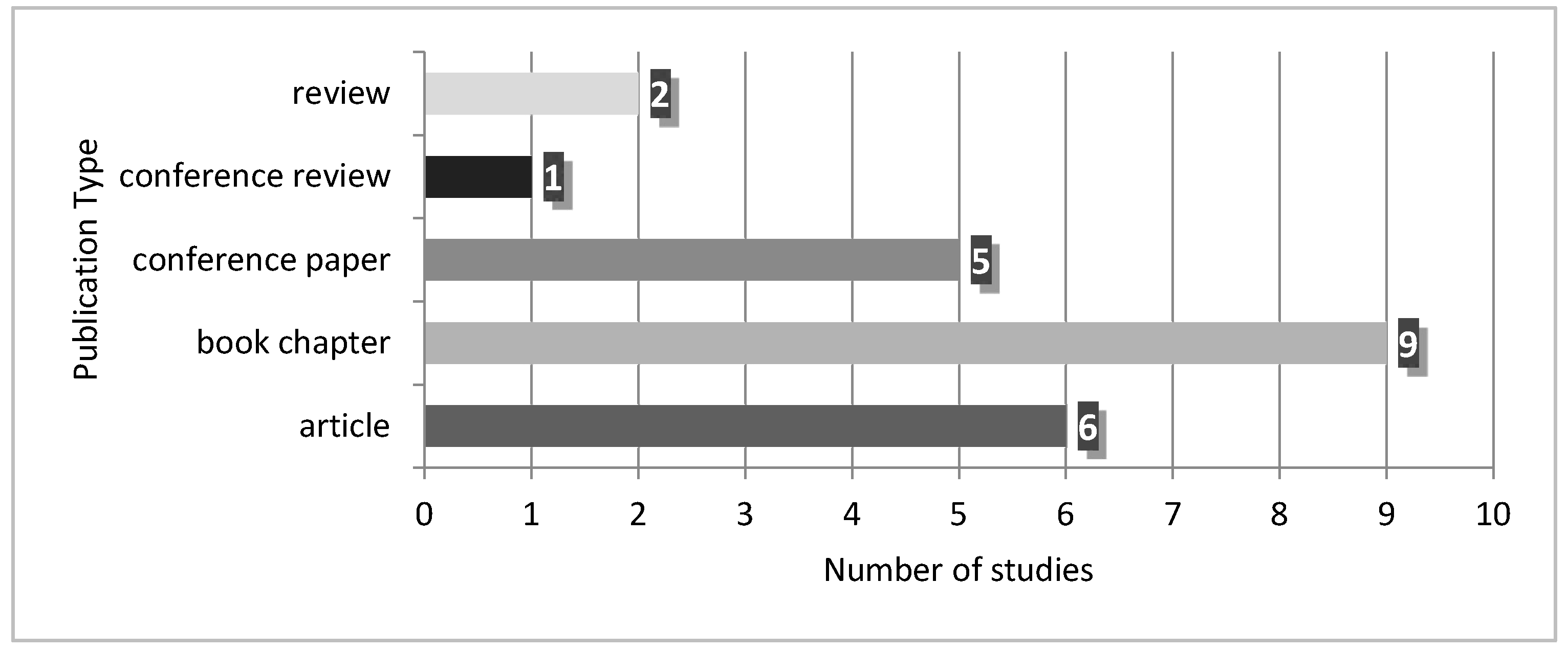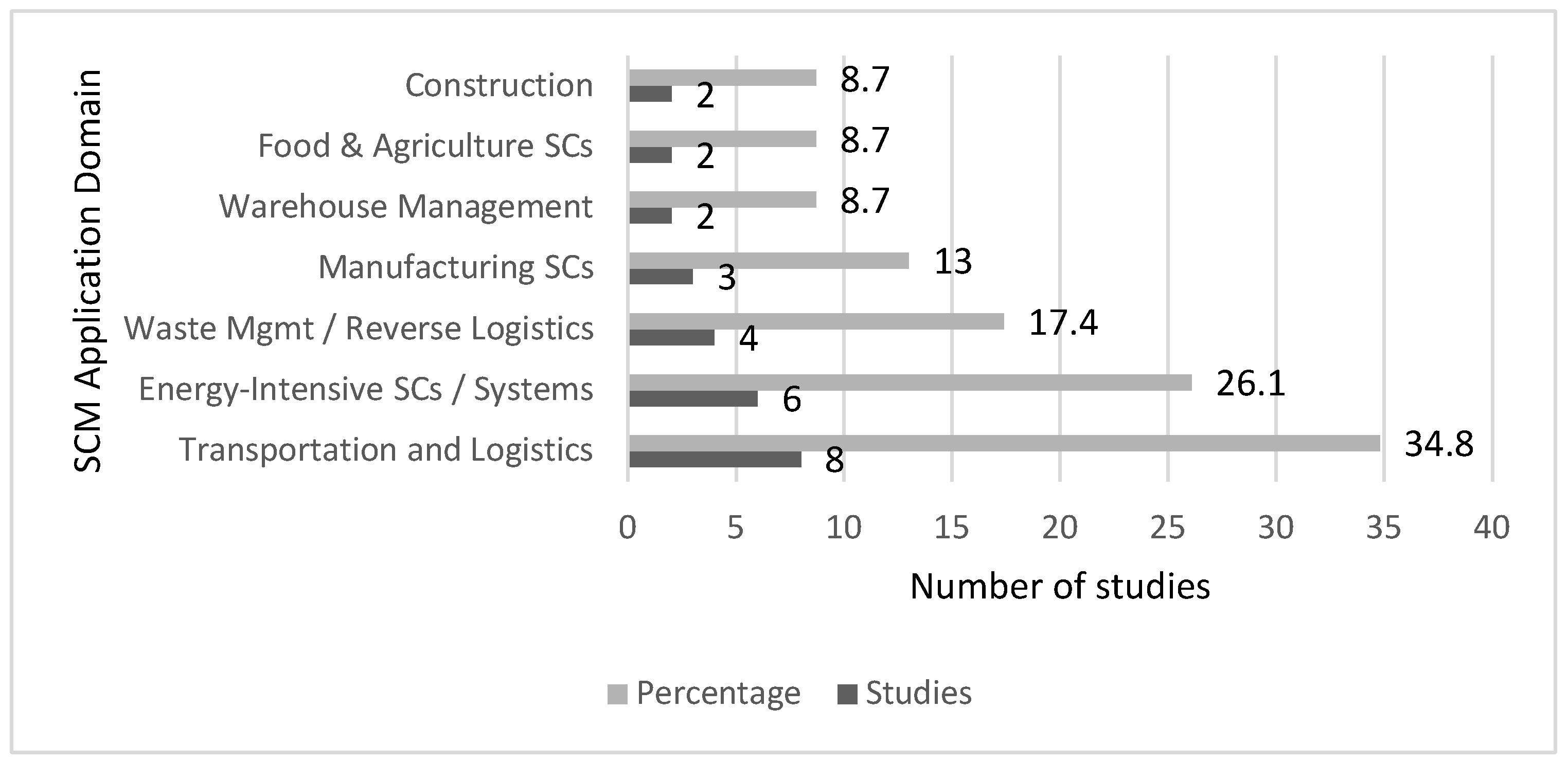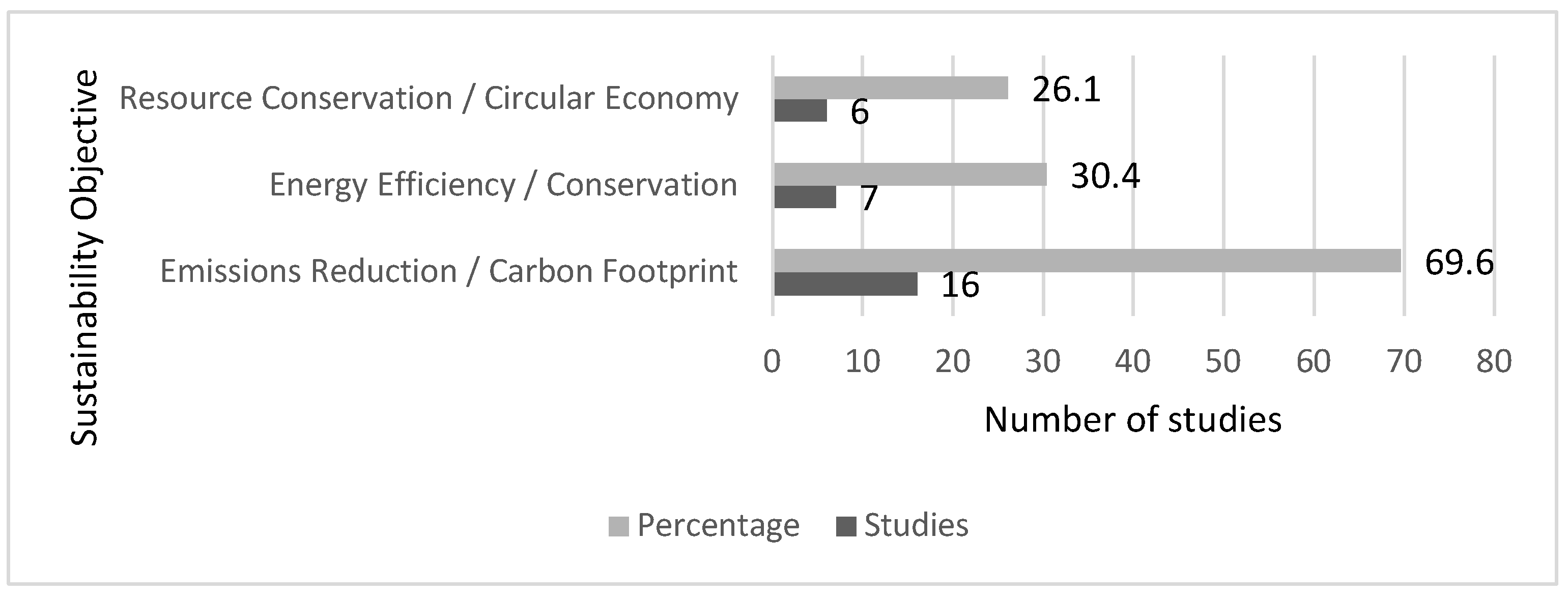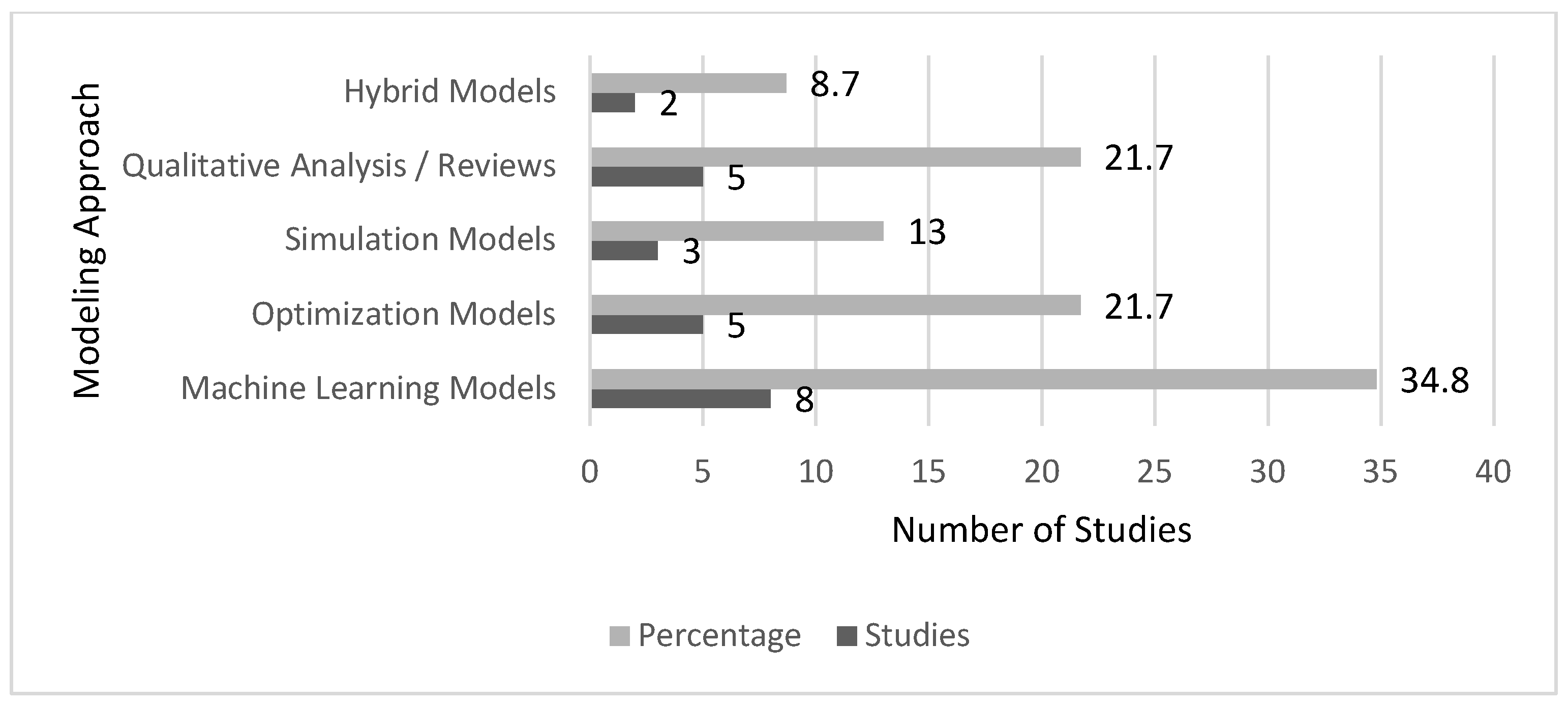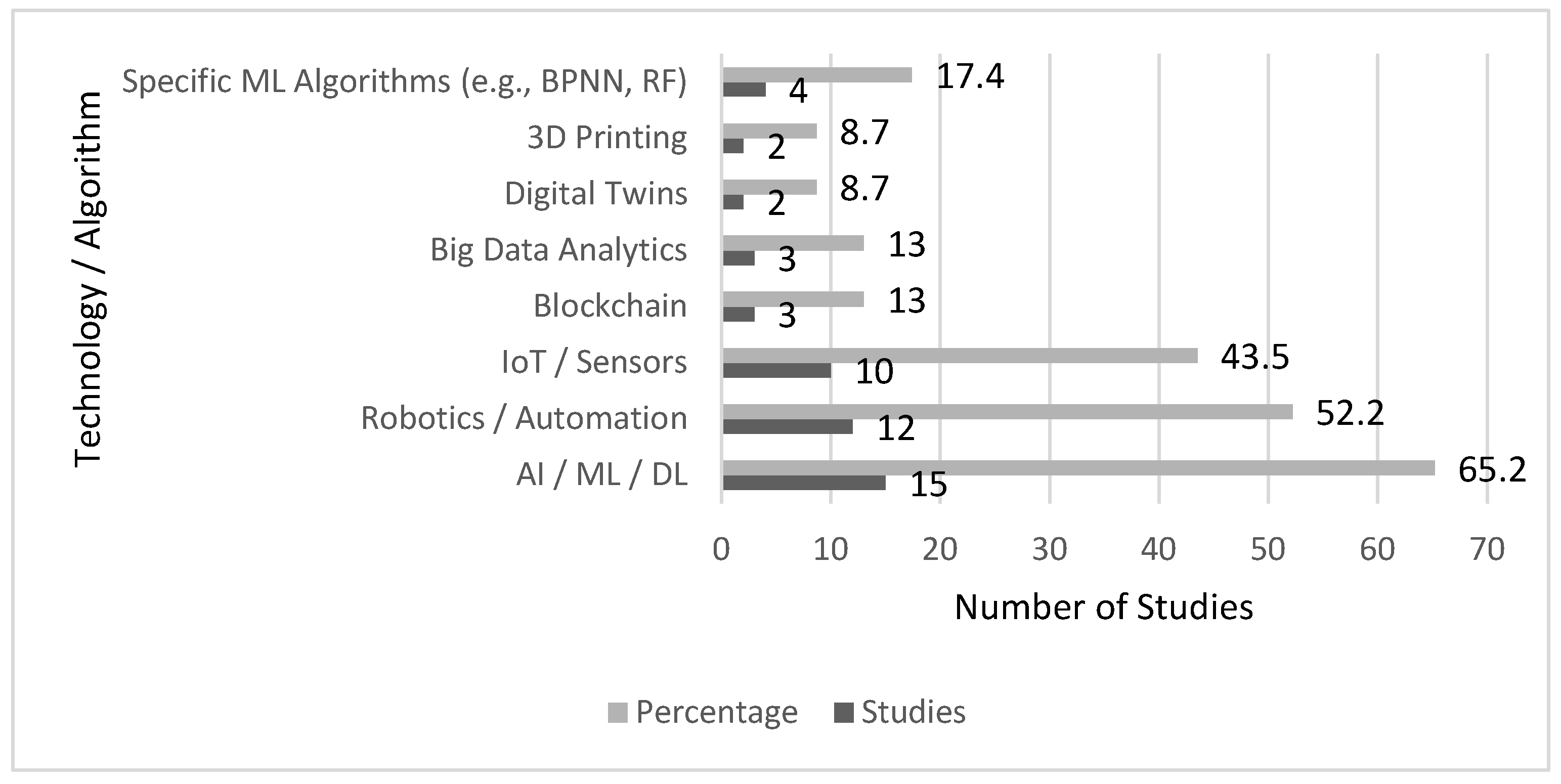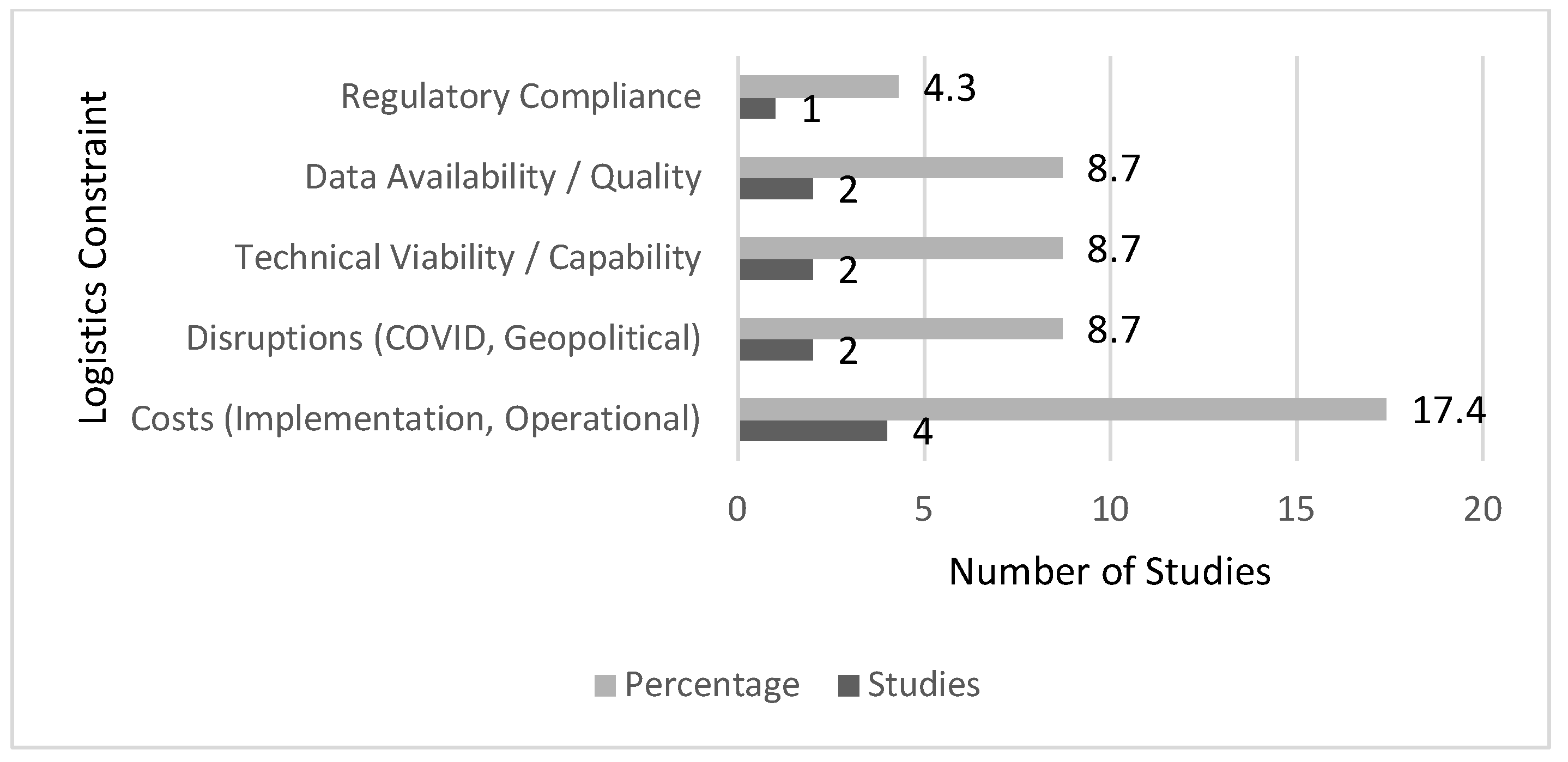1. Introduction
Supply chain management (SCM) coordinates complex networks of logistics, production, and inventory, contributing approximately 13% of global carbon emissions, with transportation alone accounting for 28% in major economies [
1]. The rise of global trade and e-commerce has amplified SCM’s environmental footprint, making emissions reductions a critical priority. Sustainable supply chain management (SSCM) has evolved since the early 2000s, driven by environmental concerns, stakeholder expectations, and the triple bottom line—economic, environmental, and social dimensions [
2]. SCM encompasses interconnected processes, such as procurement, production, logistics, and inventory management, which collectively have a significant environmental impact. Traditional SCM prioritized cost and speed, often overlooking emissions from energy-intensive warehousing and logistics [
3].
Modern SCM leverages data analytics, automation, and interconnected systems to enhance efficiency. These technological advancements position AI and robotics as transformative tools for decarbonizing SCM [
4]. In the context of this study, AI is defined as a collection of advanced computational technologies, including machine learning and optimization algorithms, that enable systems to sense, reason, act, and adapt to complex SCM datasets, such as demand forecasts and transportation patterns, to enable precise, emission-reducing decisions [
5]. Robotics, such as automated guided vehicles (AGVs) and robotic arms, automates energy-intensive tasks, reducing human error and carbon footprints [
3]. For instance, AI-driven predictive analytics can optimize delivery routes, potentially reducing logistics emissions by 15%, while robotic automation in warehousing may cut energy consumption by up to 20% [
5]. These advancements align with global sustainability initiatives, such as the European Union’s Green Deal and U.S. low-carbon logistics programs [
6]. Applications span high-impact SCM domains, including transportation, smart warehousing, waste management, and green manufacturing [
7]. However, the complexity of global supply networks and their environmental impact present significant challenges to achieving sustainability goals.
Despite two decades of SSCM research, studies on AI and robotics remain fragmented across disciplines such as data science, robotics engineering, and operations management [
8,
9]. While existing literature reviews have explored related topics, they exhibit specific limitations that this study aims to address (
Table 1). For example, reviews on green logistics or general AI applications often lack a specific, combined focus on AI and robotics for holistic SCM decarbonization [
10]. Furthermore, many reviews do not employ a systematic, reproducible methodology, and few have critically examined the validation strategies used to substantiate claims of emissions reduction. Challenges such as algorithmic biases, data quality issues, AI’s own energy demands, and ethical concerns (e.g., job displacement) are also understudied in this specific context [
11]. This gap necessitates a unified, systematic analysis of trends, methodologies, and validation strategies to consolidate evidence and guide future efforts.
To address this gap, this study presents a systematic scoping review of AI and robotics for reducing carbon emissions in SCM, analyzing 23 peer-reviewed studies (2013–2024) from an initial pool of over 2100 Scopus-indexed articles. This approach is ideal for mapping the existing literature, identifying key research trends, and highlighting gaps in this emergent, interdisciplinary field. In a systematic mapping study, it is crucial to first establish the temporal and disciplinary landscape of the research before delving into its specific characteristics. The primary objectives of this study are as follows:
To provide a systematic scoping review of AI and robotics methods for low-carbon SCM, offering an unbiased resource via a validated search process.
To propose a flexible framework for classifying and evaluating techniques, prioritizing energy efficiency and scalability.
To discuss emerging challenges and future directions, grounded in empirical findings from 2013–2024.
To provide a comprehensive and structured analysis, this scoping review is guided by three research questions (RQs):
Objective: To examine study distribution across years, journals, and research types, identifying active areas and key contributors.
Objective: To classify studies by focus, such as predictive emissions modeling, optimized logistics, or automated warehousing.
Objective: To evaluate validation approaches (e.g., simulations, field studies, analytical models) for robustness.
These RQs provide a framework for this review: RQ1 maps the research landscape, RQ2 details the technological and contextual focus of the innovations, and RQ3 assesses the quality and robustness of the evidence, collectively advancing the understanding of sustainable SCM.
To our knowledge, this is the first systematic scoping review synthesizing AI and robotics for low-carbon SCM from a sustainability perspective. It provides a replicable overview of trends, methodologies, and validation strategies, fostering interdisciplinary collaboration with fields such as environmental science. This study lays a foundational framework for advancing the design of sustainable SCM systems, enhancing emissions forecasting, and deploying robotic automation to meet the pressing challenge of decarbonization.
The remainder of this paper is organized as follows:
Section 2 provides background on AI, robotics, and SCM sustainability.
Section 3 details the methodology.
Section 4,
Section 5 and
Section 6 present results, applications, and challenges.
Section 7 comprises the discussion, and finally,
Section 8 concludes with future directions.
2. Methodology
This systematic review was conducted and reported following the guidelines of the Preferred Reporting Items for Systematic Reviews and Meta-Analyses extension for Scoping Reviews (PRISMA-ScR) checklist [
14]. This study employs a three-stage methodology including preparation, analysis, and consolidation guided by the PRISMA framework and systematic review guidelines from software engineering [
15]. This approach ensures transparency, rigor, and reproducibility while synthesizing research on AI and robotics for reducing carbon emissions in SCM. It examines publication trends, technological applications, and validation strategies, incorporating feedback from SCM sustainability and validating findings. This aligns this study with decarbonization goals and addresses the environmental challenges of global supply chains.
2.1. Stages of the Systematic Evaluation
A structured methodology was adopted to develop a comprehensive understanding of the application of AI and robotics in low-carbon SCM.
Preparation stage: This review was initiated by formulating three RQs designed to investigate publication trends (RQ1), technological characteristics (RQ2), and validation strategies (RQ3) in alignment with the overarching aim of supporting SCM decarbonization. Following established best practices, a research protocol was developed internally to ensure methodological transparency and reduce potential bias [
16]. Although not registered in a public repository, the protocol included the definition of a search strategy targeting the Scopus database, the specification of inclusion and exclusion criteria (peer-reviewed articles published in English between 2013 and 2024 addressing AI or robotics for carbon reduction in SCM), and the selection of analytical frameworks. Consistent with the principles of scoping reviews, no formal critical appraisal of individual studies was conducted; the primary objective was to map the breadth and characteristics of the existing literature [
17].
Analysis stage: The protocol was operationalized through a systematic and replicable procedure. A comprehensive search strategy (detailed in
Section 2.2) was employed, combining automated searches of the Scopus database with manual techniques such as citation snowballing. The defined eligibility criteria were applied during the screening phase, narrowing the initial dataset to 23 studies deemed relevant for inclusion. Data extraction was carried out using a standardized charting form, which was initially piloted and subsequently implemented. Data were charted by one researcher (M.M.) and independently verified by a second researcher (M.A.F.) to ensure consistency and accuracy. Thematic synthesis was used to categorize findings, supported by quantitative analysis where appropriate.
Consolidation stage: The final stage involved synthesizing the extracted data into meaningful insights. The results were organized to address RQ1 through RQ3, identifying emerging trends, key technological applications, and patterns in validation approaches. Potential sources of bias, including publication and language bias, were considered in the interpretation process. To strengthen face validity, the preliminary findings were reviewed by an expert in AI and a sustainability specialist in SCM, whose feedback informed the refinement of the classification framework and the interpretation of key patterns. The outcomes of this process are presented in this comprehensive manuscript, which provides evidence-based recommendations for future research and practical implementation in the context of SCM decarbonization.
2.2. Search Strategy
To ensure a comprehensive and methodologically sound evidence base, the literature search was conducted using the Scopus database, selected for its broad disciplinary coverage and indexing of high-quality, peer-reviewed sources. A multi-stage strategy was designed to balance exhaustiveness with relevance, combining structured database querying with complementary manual techniques.
2.2.1. Justification for Database Selection
Scopus was chosen as the exclusive database for initial retrieval due to its status as one of the largest and most robust bibliographic platforms. It offers extensive coverage of journals and conference proceedings in engineering, computer science, business, and environmental science, all of which are central to the interdisciplinary scope of this study. Although no single database can guarantee complete coverage, Scopus is widely acknowledged for its high-quality indexing and reliability in systematic and scoping reviews. To enhance completeness and reduce the risk of selection bias, the primary search was supplemented with citation snowballing, whereby the reference lists of included studies were manually reviewed to identify additional relevant works.
2.2.2. Search Query Development
The search query was constructed to be both inclusive and precise, focusing on capturing the literature that explicitly addresses applied AI and robotics in the context of sustainable supply chain management. Particular emphasis was placed on keywords such as “machine learning” and “deep learning”, which represent prominent and operational subfields of AI frequently referenced in SCM applications. This pragmatic keyword strategy ensured the retrieval of studies with a clear technological and implementation-oriented focus while avoiding overly conceptual discussions of “Artificial Intelligence” that lack direct applicability.
The final search string executed in Scopus was as follows:
(TITLE-ABS-KEY (“Artificial Intelligence” OR “AI” OR “deep learning” OR “machine learning” OR “neural networks”) AND TITLE-ABS-KEY (“Robotics” OR “robotic systems” OR “automation” OR “robotic process automation”) AND TITLE-ABS-KEY (“Carbon Emissions” OR “CO2 emissions” OR “greenhouse gases” OR “carbon footprint”) AND TITLE-ABS-KEY (“Supply Chain Management” OR “SCM” OR “logistics” OR “supply chain”)) AND PUBYEAR > 2012 AND PUBYEAR < 2025 AND (LIMIT-TO (LANGUAGE, “English”))
This query searched within titles, abstracts, and keywords (TITLE-ABS-KEY) using the Boolean operator “AND” to link the four concept groups, ensuring that retrieved documents addressed all aspects concurrently. The search was restricted to publications between 2013 and 2024 (inclusive, implemented via PUBYEAR > 2012 AND PUBYEAR < 2025) and limited to English-language articles.
The multi-stage study selection process was conducted following the PRISMA 2020 guidelines and is illustrated in the flow diagram (
Figure 1).
An initial search of the Scopus database yielded 2100 records. After the removal of 100 duplicates, 2000 unique records were advanced to the screening stage. During this phase, 1600 records were excluded based on filtering criteria for publication year, language, and document type, leaving 400 articles for a full-text eligibility assessment. Following this detailed review, 377 articles were further excluded for the following reasons: a lack of focus on carbon emissions reduction (n = 250); an irrelevant SCM context (n = 55); an incorrect publication type, such as not being peer-reviewed (n = 45); or no clear application of AI or robotics (n = 27). This rigorous selection process resulted in a final sample of 23 primary studies for inclusion in this systematic review.
3. Existing Literature Reviews on AI and Robotics in Low-Carbon Supply Chain Management
The integration of AI and robotics into SCM is a key strategy for reducing carbon emissions amid growing environmental pressures and regulatory demands [
18]. As supply chains contribute approximately 13% of global greenhouse gas emissions, these technologies offer solutions to align SCM with sustainability goals, balancing economic efficiency, environmental responsibility, and social equity [
19]. This section provides context for understanding how AI and robotics enable low-carbon SCM, laying the foundation for the systematic review.
3.1. Supply Chain Management and Sustainability
Sustainable supply chain management (SSCM) has evolved since the early 2000s, driven by environmental concerns, stakeholder expectations, and the triple bottom line—economic, environmental, and social dimensions [
20]. SCM encompasses interconnected processes, such as procurement, production, logistics, inventory management, and reverse logistics, which collectively have a significant environmental impact [
21]. Transportation in particular accounts for a substantial share of emissions in major economies [
22].
Traditional SCM prioritized cost and speed, often overlooking emissions from energy-intensive warehousing and logistics [
23]. AI and robotics have shifted this paradigm by enabling data-driven optimization and automation [
13]. For example, AI-optimized routing and robotic warehouse automation reduce emissions and energy use, supporting compliance with environmental regulations [
10]. Digital innovations, including blockchain and the Internet of Things (IoT), enhance transparency, enabling sustainable sourcing and emissions tracking [
24]. However, high implementation costs and data integration challenges persist, necessitating a systematic synthesis of the impacts of AI and robotics on low-carbon SCM [
25].
3.2. Role of AI and Robotics in SCM
AI, including machine learning and optimization algorithms, processes complex SCM datasets, such as demand forecasts and transportation patterns, to enable precise, emission-reducing decisions [
26]. Robotics, such as automated guided vehicles (AGVs) and robotic arms, automates energy-intensive tasks, reducing human error and carbon footprints [
27]. For instance, AI-driven demand forecasting minimizes overproduction, while robotic automation in warehousing cuts energy consumption by up to 20% [
26]. These technologies address SCM’s complexity, including global networks and diverse emission sources [
28].
Unlike traditional static methods, AI and robotics use real-time data and predictive analytics to optimize sustainability outcomes. They enhance resilience by predicting disruptions and supporting circular economy practices, such as recycling and reuse systems, through reverse logistics [
29]. Challenges such as high costs, data quality issues, algorithmic biases, and AI’s energy demands require careful consideration to maximize environmental benefits [
11]. These complexities highlight the need for a systematic review to evaluate AI and robotics in low-carbon SCM, as detailed in the methodology.
3.3. Research Gap and Justification for a Systematic Review
SCM’s significant environmental impact, particularly arising from transportation and production processes, underscores the urgent need for innovative, technology-driven solutions to support decarbonization efforts [
22]. Among these, AI and robotics have emerged as promising tools capable of optimizing operations and reducing emissions. However, despite their increasing adoption, a clear research gap persists; no systematic reviews currently synthesize the combined contributions of AI and robotics to low-carbon SCM. A Scopus database search spanning the period 2013–2024, using keywords such as “AI”, “robotics”, and “carbon emissions”, identified 23 relevant primary studies but revealed no comprehensive reviews focused specifically on this intersection [
30]. Existing literature reviews in the domains of green logistics or AI in operations management either overlook robotics or fail to adopt an integrated perspective on SCM decarbonization [
10].
For instance, while the role of AI in reducing logistics-related emissions is well established, its potential synergy with robotics across various SCM functions, such as manufacturing, warehousing, and last-mile delivery, remains largely underexplored [
26]. Moreover, several critical challenges, such as algorithmic biases, data heterogeneity, and ethical concerns, including job displacement, have received limited attention within this context [
11].
To address these limitations, a systematic review is necessary to consolidate fragmented knowledge, identify effective technological strategies, and provide guidance to both researchers and practitioners [
24]. Such reviews adopt rigorous, transparent, and reproducible methodologies that go beyond narrative syntheses, ensuring objectivity and analytical depth [
31,
32]. The approach employed here draws from established guidelines in software engineering and SCM research, emphasizing structured search protocols and robust data extraction methods [
33,
34]. This includes the definition of precise research questions [
35], the systematic searching and screening of studies, and the reporting of results in accordance with the PRISMA guidelines [
36].
Given the interdisciplinary nature of SCM, spanning logistics, production, and sustainability science, this study adapts these methodological standards to specifically investigate the role of AI and robotics in reducing supply chain emissions, as elaborated in
Section 2 [
37]. By leveraging this systematic framework [
38], the present review aims to achieve three core objectives: (1) to synthesize and categorize technological approaches and validation strategies that support low-carbon transitions [
18]; (2) to highlight how the integration of AI and robotics can simultaneously reduce emissions and improve economic efficiency [
13,
26,
28]; and (3) to support the broader transition toward resilient and sustainable supply chains aligned with global decarbonization goals [
13,
24].
4. Publication Trends (RQ1)
To address RQ1 (What are the publication trends of research studies on AI and robotics for reducing carbon emissions in SCM?), we analyzed bibliographic data from 23 peer-reviewed studies selected through a systematic review. This section examines the evolution, volume, and venues of these publications from 2013 to 2024, offering insights into the research landscape of AI, robotics, and carbon emissions reduction in SCM. The analysis begins with the publication timeline to highlight temporal dynamics.
4.1. Publication Timeline
Figure 2 shows the distribution of the 23 studies from 2013 to 2024, revealing distinct trends.
Initial Sparse Period (2013–2018): Research activity was minimal, with only one study (4.3%) published in 2013 and a subsequent five-year lull. This suggests the intersection of AI, robotics, and SCM decarbonization was a nascent field, with the single 2013 publication being a conference review that indicated early, conceptual-level work rather than applied research [
39].
Emergence and Growth (2019–2023): The field began to gain momentum as publications increased gradually, with nine studies (39.1%) appearing over these years. This steady output reflects a growing academic and practical interest in leveraging advanced technologies for sustainable SCM, moving from concept to initial exploration.
Rapid Acceleration (2024): The most significant trend is a sharp surge in 2024, which alone produced 13 studies (56.5% of the total sample). This dramatic acceleration highlights the field’s current relevance and its maturation into a significant area of research, likely driven by both technological progress and pressing global decarbonization goals.
The trend shows a positive trajectory, with a compound annual growth rate (CAGR, a measure of annual growth) of 26.26%, driven by the 2024 spike. This aligns with advancements in Industry 4.0 technologies (e.g., AI and IoT) and global sustainability imperatives, such as the IPCC Synthesis Report [
40].
4.2. Publication Types and Venues
Figure 3 illustrates the distribution between book chapters (39.1%), articles (26.1%), conference papers (21.7%), reviews (8.7%), and one conference review (4.3%). The dominance of book chapters is notable, perhaps indicating a preference for comprehensive, thematic explorations in this emerging field. The 23 studies came from 23 unique sources, highlighting the topic’s multidisciplinary nature.
The dominance of book chapters (39.1%) is notable, as systematic reviews in SCM typically feature a higher proportion of journal articles. This may indicate a preference for comprehensive, thematic explorations in this emerging field, where book chapters allow for in-depth discussions. Journal articles (26.1%) and conference papers (21.7%) follow, suggesting a balanced mix of rigorous, peer-reviewed research and timely dissemination. The diversity of publication venues—23 unique sources for 23 studies—highlights the multidisciplinary nature of the field, spanning SCM, engineering, and sustainability domains.
The high proportion of book chapters contrasts with typical SCM systematic reviews, where journal articles often dominate (e.g., 65% in [
40]). This difference may reflect the early stage of AI and robotics in low-carbon SCM, where researchers are consolidating foundational knowledge through integrative formats. Synthesizing these trends and characteristics, the following subsection consolidates the key findings to address RQ1 comprehensively.
4.3. Dataset Overview
The 23 studies cover applications such as predictive emissions modeling, logistics optimization, and robotic automation, addressing SCM’s environmental challenges across diverse domains (e.g., logistics, waste, energy).
4.4. Synthesis of Findings
The analysis reveals key insights for RQ1.
Exponential Growth: The surge in 2024 (56.5% of studies) and a CAGR of 26.26% reflect rapid field evolution, driven by AI/robotic advancements and sustainability demands [
40].
Diverse Dissemination: Book chapters (39.1%), articles (26.1%), and conference papers (21.7%) indicate multifaceted knowledge sharing, with book chapters emphasizing foundational discussions.
Timeliness and Momentum: The 2024 concentration underscores the field’s relevance, responding to global climate goals. The 23 unique venues highlight interdisciplinary collaboration.
These findings indicate a maturing field at a critical juncture, with increasing output and diverse strategies positioning AI and robotics as pivotal for SCM decarbonization, as illustrated in
Table 2.
5. Characteristics and Focus of Research (RQ2)
This section addresses RQ2:
What are the characteristics and focus of existing research on AI and robotics for reducing carbon emissions in SCM? We analyzed 23 primary studies selected through the systematic review process outlined in
Section 3. Using the evaluation framework from
Section 4.3, we extracted and synthesized data on application domains, research perspectives, sustainability objectives, SCM components, modeling approaches, algorithms, logistics constraints, and emissions reduction strategies. By deconstructing the literature across these facets, this analysis provides a comprehensive overview of how AI and robotics are being leveraged to enhance SCM sustainability. This multi-dimensional mapping not only reveals what has been studied but also uncovers the underlying methodologies and assumptions driving the field, highlighting dominant trends, technological synergies, and critical research gaps. We begin by exploring the SCM application domains most frequently targeted by the existing research.
5.1. SCM Application Domain
AI and robotics applications for SCM decarbonization span multiple domains, as summarized in
Table 3. Studies often address interconnected domains, resulting in non-exclusive categories.
Transportation and Logistics (8 studies, 34.8%): Focuses on digitalizing transport modes (road, rail, sea, air), optimizing routes, and enhancing intermodal efficiency.
Energy-Intensive Supply Chains/Systems (6 studies, 26.1%): Includes demand forecasting, low-carbon energy transitions, and applications in oil and gas and agriculture.
Waste Management/Reverse Logistics (4 studies, 17.4%): Covers IoT/AI-driven waste sorting, valorization (e.g., pyrolysis), and circular-economy principles.
Manufacturing Supply Chains (3 studies, 13.0%): Addresses green transitions in industries such as fashion and oil palm processing.
Warehouse Management (2 studies, 8.7%): Focuses on intelligent automation and robotic material handling.
Food and Agriculture Supply Chains (2 studies, 8.7%): Emphasizes digitalization for sustainability and food security.
Construction (2 studies, 8.7%): Includes waste management and green building energy optimization.
The analysis reveals a strong emphasis on transportation and logistics, reflecting its significant contribution to SCM emissions (estimated at 28% by IEA [
63]) and the potential for AI-driven route optimization to achieve reductions, as demonstrated by a 15% emissions decrease [
4]. Energy-intensive supply chains and waste management are also prominent, driven by their environmental impact and opportunities for automation and IoT integration. Industry-specific applications, such as fashion and agriculture, indicate tailored solutions.
Emerging areas such as warehouse management and construction suggest growing interest in automation, pointing to a diverse research landscape, as illustrated in
Figure 4. The perspectives adopted in these studies illuminate their methodological approaches.
5.2. Research Perspectives
The 23 studies approach SCM decarbonization from various methodological standpoints, as detailed in
Table 4. A single study often incorporates multiple perspectives.
Optimization (10 studies, 43.5%): Focuses on improving efficiency to reduce environmental impact (e.g., route optimization, energy management).
Analysis/Monitoring/Forecasting (8 studies, 34.8%): Involves tracking performance, predicting emissions, or analyzing trends.
Development/Implementation (3 studies, 13.0%): Describes the creation or practical deployment of systems.
Optimization dominates, underscoring SCM’s focus on efficiency as a pathway to emissions reduction, such as through AI-optimized logistics networks [
4]. The emphasis on analysis/monitoring/forecasting highlights the role of predictive analytics and IoT in data-driven sustainability strategies, as presented in
Figure 5.
The lower prevalence of development/implementation studies, as noted by [
13], suggests a gap in translating theoretical advancements into practice, with only [
39] detailing robotic system deployment. This distribution reflects a field prioritizing technological optimization and data insights over immediate deployment.
5.3. Sustainability Objectives
The studies target various sustainability objectives, emphasizing direct environmental benefits, as shown in
Table 5. Studies often pursue multiple objectives.
Emissions Reduction/Carbon Footprint (16 studies, 69.6%): Targets direct greenhouse gas reductions across SCM activities.
Energy Efficiency/Conservation (7 studies, 30.4%): Focuses on minimizing energy consumption in operations such as warehousing, manufacturing, and building management.
Resource Conservation/Circular Economy (6 studies, 26.1%): Emphasizes waste reduction, sustainable resource use, and circular economy principles.
Direct emissions reduction is the primary objective, reflecting global commitments such as the Paris Agreement [
40]. Energy efficiency and resource conservation are key complementary strategies, with the growing focus on the circular economy indicating a shift toward more holistic sustainability frameworks. This focus defines the central challenge addressed by most studies through technological innovation. Complementary strategies, including energy efficiency improvements and resource conservation, are frequently emphasized, with warehouse automation research [
5] illustrating the interdependence of these approaches. These secondary aims often function as pragmatic pathways to achieving the overarching goal of carbon-footprint minimization. Moreover, the increasing attention on circular economy principles evidences a progressive shift toward comprehensive sustainability frameworks that transcend mere emission reductions to encompass the full lifecycle of products and materials, as illustrated in
Figure 6.
5.4. SCM Components
AI and robotic interventions target various SCM components, as detailed in
Table 6. Studies often address multiple components.
Transportation Systems/Networks (10 studies, 43.5%): Includes routing, scheduling, and fleet management.
Production Systems/Manufacturing (4 studies, 17.4%): Covers industrial automation and green manufacturing.
Warehouse Automation/Inventory (4 studies, 17.4%): Focuses on robotic material handling and inventory optimization.
Waste Management Systems (4 studies, 17.4%): Addresses automated waste sorting and valorization.
Energy Management Systems (3 studies, 13.0%): Involves demand response and energy optimization.
Transportation systems dominate due to their emissions share [
63], with AI-driven routing achieving significant reductions [
4]. Manufacturing, warehouse automation, and waste management reflect operational importance, while energy management indicates growing interest in AI for efficiency, as shown in
Figure 7.
5.5. Modeling Approaches
Various modeling approaches develop and evaluate AI and robotic solutions, as shown in
Table 7. Studies often combine approaches.
Machine Learning Models (8 studies, 34.8%): Includes neural networks, random forests, and SVMs for prediction and classification.
Optimization Models (5 studies, 21.7%): Uses mathematical techniques for route planning and energy management.
Simulation Models (3 studies, 13.0%): Evaluates system performance in complex scenarios.
Qualitative Analysis/Reviews (5 studies, 21.7%): Includes systematic reviews and case studies.
Hybrid Models (2 studies, 8.7%): Combines approaches such as optimization and simulation.
Figure 8 demonstrates that machine learning aligns with Industry 4.0 trends, supporting emissions forecasting and logistics optimization. The limited use of hybrid models suggests an area for future research [
60,
61].
5.6. Algorithms and Enabling Technologies
The research leverages advanced algorithms and technologies, as detailed in
Table 8. Studies often integrate multiple technologies.
AI/Machine Learning/Deep Learning (15 studies, 65.2%): This was the most dominant category, serving as the core analytical engine for tasks such as predictive analytics to reduce overproduction and logistics optimization to minimize fuel consumption.
Robotics/Automation (12 studies, 52.2%): Representing the physical application of technology, this category includes automated guided vehicles (AGVs) and robotic arms used to improve operational efficiency, enhance sorting precision in reverse logistics, and reduce energy usage in warehousing.
IoT/Sensors (10 studies, 43.5%): Functioning as the primary data acquisition layer, IoT infrastructure provides the real-time data on assets, fuel, and energy consumption that are essential for dynamic monitoring and feeding AI-driven decision models.
Blockchain (3 studies, 13.0%): Though an emerging technology in this sample, blockchain is highlighted for its ability to enhance supply chain traceability by creating an immutable ledger for verifying sustainability claims and tracking carbon footprints.
Big Data Analytics (3 studies, 13.0%): These techniques are identified as crucial for processing the large and complex datasets generated by modern supply chains, enabling the effective application of machine learning for strategic insights.
Digital Twins (2 studies, 8.7%): As a nascent but powerful tool, digital twins were used to create virtual replicas of supply chain processes, primarily for advanced simulation to test and validate the impact of decarbonization strategies in a risk-free environment.
AI/ML dominates, supporting diverse SCM tasks. Robotics enhances efficiency in warehousing and reverse logistics, while IoT provides data for real-time analytics. Emerging technologies such as blockchain and digital twins indicate novel approaches, with blockchain improving transparency [
55], as shown in
Figure 9.
5.7. Logistics Constraints
Studies acknowledge logistics constraints impacting AI and robotics adoption, as shown in
Table 9.
Costs (Implementation, Operational) (4 studies, 17.4%): High initial and ongoing costs are key barriers.
Disruptions (COVID, Geopolitical) (2 studies, 8.7%): Pandemics and instability affect resilience.
Technical Viability/Capability (2 studies, 8.7%): Challenges in technology maturity or integration.
Data Availability/Quality (2 studies, 8.7%): Issues with reliable data for AI models.
Regulatory Compliance (1 study, 4.3%): Compliance with waste regulations, critical in circular-economy applications.
Costs are the most cited constraint, reflecting financial barriers to adopting AI and robotics [
13]. Disruptions, technical viability, and data quality are equally noted, while regulatory compliance is less frequent but significant in waste management [
55]. The limited coverage (11 studies) suggests a gap in addressing practical barriers, as presented in
Figure 10.
5.8. Emissions Reduction Strategies
Studies employ strategies leveraging AI and robotics to reduce emissions, as summarized in
Table 10.
Optimization (10 studies, 43.5%): Refines processes such as routing and waste management to lower emissions.
Monitoring/Forecasting (8 studies, 34.8%): Tracks and predicts emissions using AI and IoT.
Hybrid (3 studies, 13.0%): Combines optimization, monitoring, and simulation.
Optimization leads, achieving up to 15% emissions reductions [
4]. Monitoring/forecasting supports proactive management, while hybrid approaches integrate multiple methods for comprehensive solutions [
61]. The focus on emissions reduction (91.3% of studies) aligns with
Table 5′s objectives [
40].
5.9. Synthesis of Findings
The analysis reveals a dynamic research landscape leveraging AI and robotics for SCM sustainability. Transportation and logistics (34.8%) and energy-intensive systems (26.1%) are primary domains, reflecting their environmental impact [
63]. Optimization (43.5%) and emissions reduction (69.6%) dominate perspectives and objectives, driven by machine learning (34.8% of models, 65.2% of technologies) and robotics (52.2%), with IoT (43.5%) enabling real-time control [
4,
13].
Emerging technologies such as blockchain (13.0%) and digital twins (8.7%) indicate novel approaches [
55]. However, implementation costs (17.4%) and data quality issues (8.7%) pose barriers [
13]. The limited use of hybrid models [
61] suggests a research gap. This review is limited by its focus on 23 studies, potentially overlooking regional variations or unpublished works.
For practitioners, adopting AI for logistics optimization and robotics for automation offers immediate benefits. Policymakers should support technology adoption for small and medium enterprises (SMEs) through incentives. Researchers should focus on practical implementation, hybrid models, and longitudinal studies to bridge theoretical and real-world gaps. The interdisciplinary nature of this research necessitates cross-sectoral collaboration for sustainable SCM practices.
6. Validation Strategies (RQ3)
This section addresses Research RQ3: What validation strategies are employed in research on AI and robotics for reducing carbon emissions in SCM? For the purposes of this review, validation strategies are defined as the specific methods used by researchers to demonstrate the credibility, feasibility, or effectiveness of their proposed AI- and robotics-based solutions for SCM decarbonization. This clarification addresses the distinction between an overall research method and the specific validation methods used within a study to support its claims (e.g., performance of a machine learning model, a simulation). These validation methods are components of the broader research approach but are analyzed here specifically to assess the nature and robustness of the evidence provided.
A total of 23 primary studies, systematically selected as described in
Section 3, were examined, with a focus on research types, validation methodologies, simulation and experimental setups, and provisions for reproducibility and replication. The analysis reveals a range of methodological practices, from conceptual modeling and numerical simulation to real-world experimentation, and exposes notable gaps in validation rigor across certain subdomains. These findings provide critical insight into the current state of empirical support and the maturity of AI and robotics applications aimed at decarbonizing supply chains.
6.1. Research Type and Predominant Validation Methods
Following systematic mapping guidelines [
1,
2] adapted for SCM sustainability, we classified the 23 studies by research type. The inclusion criteria prioritized studies proposing or evaluating AI or robotics solutions for emissions reduction, excluding philosophical or opinion-based papers. The distribution is as follows:
Solution Proposals (7 studies, 30.4%): Novel AI or robotics methods, validated via small-scale examples or theoretical arguments.
Validation Research (14 studies, 60.9%): Techniques with limited practical application, validated through mathematical proofs, case studies, simulations, or lab experiments.
Evaluation Research (2 studies, 8.7%): Assessments in real-world SCM contexts to identify practical challenges.
Validation methods vary, often combining multiple approaches, as shown in
Table 11.
Key insights include the following:
Data-Driven and Conceptual Validation: Machine Learning (34.8%) and Optimization Model performance (21.7%) dominate, supported by Sound Arguments (26.1%), Small-scale Examples (30.4%), and Qualitative Analysis (21.7%). This reflects a focus on theoretical viability and algorithmic efficacy.
Limited Empirical Methods: Low use of Simulation (13.0%) and Experiments (8.7%), combined with scarce Evaluation Research (8.7%), highlights a gap in validating solutions in dynamic SCM environments. Real-world pilot studies are needed to bridge this gap.
6.2. Application of Simulation Models
Simulation models are used in three studies (13.0%) to validate emissions reduction strategies, aligning with
Section 5.5 (
Table 7).
Table 12 details their usage.
Limited Simulation Use: Only three studies employ simulations, with two using the same model as their analytical approach [
51,
55] and one using a different model to address SCM complexities [
53].
Absence of Simulation: Most studies (87.0%) rely on mathematical proofs, model testing, or qualitative methods, limiting assessment under dynamic SCM conditions.
6.3. Repeatability and Replication
Repeatability ensures independent reproduction of validation results based on study descriptions. We assessed repeatability by evaluating details on validation steps, software/tools, testbeds, and datasets.
Figure 11 (placeholder, not provided) would illustrate the distribution, but specific counts for the 23 studies are unavailable. Qualitatively,
Studies using standard tools (e.g., AnyLogic 8.9, TensorFlow 2.12) with clear methodologies likely have higher repeatability [
51,
55,
58];
Studies with ad hoc systems or vague descriptions have lower repeatability [
43,
48];
Theoretical or small-scale studies are classified as “Not Applicable” for simulation/experiment-based repeatability [
42,
46].
No study in the 23-study sample provided a replication package (e.g., code, datasets, instructions), consistent with the broader dataset. This absence hinders verification and slows research progress. Standardized SCM validation frameworks and detailed reporting are needed to improve repeatability.
Figure 11.
Distribution of studies by emissions reduction strategy.
Figure 11.
Distribution of studies by emissions reduction strategy.
7. Discussion
This systematic scoping review examines the contributions of AI and robotics to carbon emissions reduction in SCM, synthesizing evidence from 23 primary studies published between 2013 and 2024. Structured around three research questions addressing publication trends (RQ1), technological and application focus (RQ2), and validation strategies (RQ3), this review follows established systematic mapping guidelines. Unlike previous reviews that were either narrative or domain-restricted, this study offers a structured, evidence-based, and methodologically rigorous synthesis that emphasizes empirical validation and technological deployment.
The findings indicate that the field has gained significant momentum since 2019, with more than half of the included studies (56.5%) published in 2024 alone. This reflects an intensified academic focus on the role of intelligent technologies in decarbonizing SCM. Thematic concentrations are primarily found in transportation (34.8%) and energy-intensive supply chains (26.1%), sectors known for their high decarbonization potential. AI-driven optimization and robotic automation emerged as dominant approaches, with machine learning techniques applied in 65.2% of studies and robotic systems in 52.2%. This highlights a strong orientation toward operational efficiency and process automation as levers for carbon reduction.
Despite this growing interest, validation strategies remain underdeveloped. While case studies (30.4%) and model performance evaluations (34.8%) are relatively common, real-world experimentation (8.7%) and evaluation research (8.7%) are significantly underrepresented. None of the reviewed studies provided replication packages, such as open-source code, datasets, or experimental protocols, limiting reproducibility and transparency. This absence of standardized validation practices presents a critical barrier to both scientific advancement and industrial application.
Interpreting these findings through the lens of the three research questions reveals key insights. The rising number of publications (RQ1) coincides with a predominance of solution-oriented and validation research (RQ3), suggesting heightened academic engagement but limited methodological maturity. The focus on transportation and logistics (RQ2) is accompanied by a reliance on simulation-based validation, with limited empirical testing under real-world conditions. Most studies depend on algorithmic benchmarks or synthetic datasets, which may not adequately reflect the variability and uncertainty inherent in operational supply chains. In contrast with earlier reviews by Handoyo [
12] and Seuring and Müller [
8], which either lacked systematic structure or omitted empirical validation, this study introduces a typology of research types, technological focus areas, and validation methods. This typology reveals a marked gap between theoretical optimization models and their empirical testing, underscoring a persistent research–practice divide.
Notably, the field is evolving from conceptual and theoretical work toward more data-driven applications. There is increasing attention to complex systems, including nonlinear optimization, predictive maintenance, and real-time anomaly detection. Emerging application domains such as reverse logistics and cold-chain food systems also suggest a diversification of AI and robotics use cases beyond traditional transportation scenarios. However, a lack of standardized evaluation frameworks, benchmark datasets, and real-world testbeds continues to hinder cumulative scientific progress and widespread industry adoption.
To bridge these limitations, four future research priorities are proposed. First, the field must address the validation gap through experimental deployments and the development of standardized testbeds—physical or digital platforms that support rigorous and comparable evaluations using shared datasets and metrics. Second, the complete absence of replication packages calls for the adoption of open-science practices. Journals and conferences should incentivize transparency by promoting artifact evaluation tracks that include code, datasets, and detailed protocols. Third, future work should move beyond deterministic optimization by exploring hybrid models, such as reinforcement learning, physics-informed AI, and multi-agent systems, to enable dynamic emissions management under uncertainty and real-time constraints. Fourth, the environmental and social impacts of AI and robotics, such as the carbon footprint of training large models or job displacement due to automation, must be more systematically assessed to ensure that technological adoption aligns with principles of responsible and equitable sustainability.
Finally, several limitations must be acknowledged. This review relied exclusively on the Scopus database, which, while comprehensive, may have excluded relevant contributions from other sources or grey literature. As a systematic mapping study, this review emphasizes classification and synthesis rather than the in-depth quality assessment of each included article. Furthermore, the lack of available replication materials hindered the ability to independently verify the reported findings. Most importantly, the limited use of real-world testbeds and pilot studies in the literature underscores a persistent divide between academic proposals and practical implementation, a gap this review highlights but cannot resolve alone.
8. Conclusions
This systematic scoping review comprehensively examined the role of AI and robotics in facilitating carbon emissions reduction within SCM. Analyzing 23 peer-reviewed studies published between 2013 and 2024, this review highlights a research domain characterized by significant promise but limited empirical maturity. While the literature is rich in theoretical modeling and algorithmic simulations demonstrating potential decarbonization benefits, there remains a pronounced scarcity of real-world deployment, rigorous validation, and reproducibility efforts. This gap underscores the nascent stage of translating innovative AI and robotic solutions into operational practice for sustainable supply chains.
This study offers three primary contributions. First, it provides a structured and systematic synthesis of a rapidly expanding interdisciplinary field, clearly identifying transportation and energy-intensive sectors as the predominant focus areas for decarbonization efforts. These sectors represent critical leverage points for impactful emissions reduction through technological innovation. Second, this review maps the evolving technological and methodological landscape, emphasizing the widespread adoption of AI-based optimization models and robotic automation as core enablers of sustainability transitions in SCM. Third, it identifies substantial deficiencies in experimental validation and reproducibility, revealing an urgent need for more practice-oriented research that can reliably inform industry and policy decisions.
To enhance both the practical relevance and scientific robustness of future research, this review advocates for a focused research agenda centered on four key priorities: (1) the implementation of real-world pilot studies and field experiments is essential to evaluate the feasibility and effectiveness of AI and robotics solutions under operational conditions; (2) the development of standardized testing environments and benchmark datasets would facilitate comparative assessments and accelerate knowledge accumulation; (3) the adoption of open-science principles, including transparent reporting and the sharing of code, data, and protocols, is critical to fostering reproducibility and cumulative learning within the field; (4) and finally, a comprehensive examination of the environmental and social trade-offs associated with deploying AI and robotics in SCM is necessary to ensure these technologies contribute to equitable and truly sustainable supply chains.
Addressing these priorities will be instrumental in unlocking the full transformative potential of AI and robotics. Such advancements are indispensable for delivering resilient, efficient, and low-carbon supply chains that align with global sustainability objectives and support the urgent transition toward a carbon-neutral economy.

